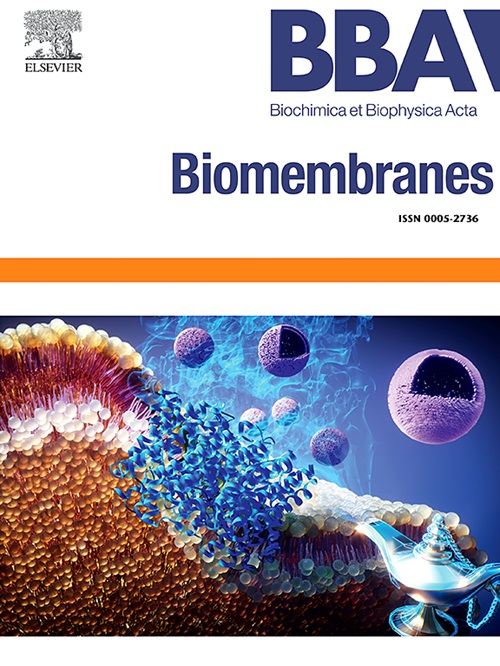Examining the thermotropic properties of large circularized nanodiscs
IF 2.5
3区 生物学
Q3 BIOCHEMISTRY & MOLECULAR BIOLOGY
引用次数: 0
Abstract
Nanodiscs, soluble membrane mimetics composed of an amphipathic membrane scaffold protein encircling a lipid bilayer, are widely used in biophysical and structural studies of membrane proteins. Because many membrane proteins are responsive to their membrane environment, through specific protein–lipid interactions and bulk membrane shape and structure, it is important to understand the properties of lipid bilayers contained within nanodiscs in order to interpret studies using this technology. Nanodiscs are known to alter lipid properties, such as membrane thickness and melting temperature, and interactions with the nanodisc rim have been hypothesized to produce local perturbations in lipid structure and dynamics. Larger nanodiscs should compensate for this effect with a larger unperturbed area. To test this hypothesis, we examined the lipid bilayer properties of several lipids (DMPC, DPPC, POPC, DSPC) and soy polar lipid in circularized nanodiscs of 11 nm to 50 nm diameter using the environmentally-sensitive fluorophore, Laurdan. In nanodiscs containing a single lipid type, as nanodisc size increased, lipid packing, melting temperature, and cooperativity better approximated the properties of that lipid in large unilamellar vesicles (LUVs). In spNW50 (50 nm nanodisc), the lipid packing and melting temperature were indistinguishable from LUVs. However, nanodiscs containing soy polar lipids did not follow this trend suggesting that complex lipid mixtures may produce preferential incorporation of lipids into the nanodisc or nonhomogeneous distribution of lipids within the nanodisc.

大型圆形纳米片的热致性研究
纳米盘是一种由两亲性膜支架蛋白包裹脂质双分子层组成的可溶性膜模拟物,广泛应用于膜蛋白的生物物理和结构研究。由于许多膜蛋白通过特定的蛋白质-脂质相互作用和大体积膜的形状和结构对其膜环境做出反应,因此了解纳米盘内脂质双层的性质对于解释使用该技术的研究非常重要。已知纳米圆盘可以改变脂质性质,如膜厚度和熔化温度,并且假设与纳米圆盘边缘的相互作用会产生脂质结构和动力学的局部扰动。更大的纳米片应该用更大的未扰动面积来补偿这种影响。为了验证这一假设,我们使用环境敏感荧光团Laurdan检测了直径为11 nm至50 nm的圆形纳米圆盘中几种脂质(DMPC、DPPC、POPC、dsc)和大豆极性脂质的脂质双分子层性质。在含有单一脂质类型的纳米圆盘中,随着纳米圆盘尺寸的增加,脂质填充、熔化温度和协同性更接近该脂质在大单层囊泡(LUVs)中的性质。在spNW50 (50 nm纳米片)中,脂质堆积和熔融温度与luv没有明显区别。然而,含有大豆极性脂质的纳米圆盘没有遵循这一趋势,这表明复杂的脂质混合物可能会使脂质优先融入纳米圆盘,或者在纳米圆盘内脂质分布不均匀。
本文章由计算机程序翻译,如有差异,请以英文原文为准。
求助全文
约1分钟内获得全文
求助全文
来源期刊

Biochimica et biophysica acta. Biomembranes
生物-生化与分子生物学
CiteScore
8.20
自引率
5.90%
发文量
175
审稿时长
2.3 months
期刊介绍:
BBA Biomembranes has its main focus on membrane structure, function and biomolecular organization, membrane proteins, receptors, channels and anchors, fluidity and composition, model membranes and liposomes, membrane surface studies and ligand interactions, transport studies, and membrane dynamics.
 求助内容:
求助内容: 应助结果提醒方式:
应助结果提醒方式:


